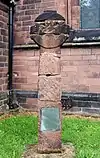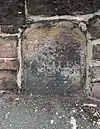Listed buildings in Bromborough
Bromborough is a village in Wirral, Merseyside, England. It contains eleven buildings that are recorded in the National Heritage List for England as designated listed buildings. Of these, two are listed at Grade II*, the middle of the three grades, and the others are at Grade II, the lowest grade. The listed buildings include houses, a church and associated structures, a school, a churchyard cross and a market cross, and a mile stone.
Key
| Grade | Criteria[1] |
|---|---|
| II* | Particularly important buildings of more than special interest |
| II | Buildings of national importance and special interest |
Buildings
| Name and location | Photograph | Date | Notes | Grade |
|---|---|---|---|---|
| Churchyard cross 53.33280°N 2.97887°W |
 |
9th or 10th century | The cross is in the churchyard of St Barnabas' Church. It was assembled from three stone fragments in 1958. Two fragments with interlace decoration form the shaft, and this carries half of a cross head in Celtic style. An additional stone at the base contains a plaque relating to its erection.[2][3] | II |
| Market Cross 53.33213°N 2.97768°W |
 |
1278 or later | The lower part of the cross is medieval, and the upper part, designed by George Gilbert Scott was added in 1874. An octagonal base stands on seven square steps. On the base is a chamfered shaft surmounted by a cap. The cap consists of a canopy carried on quatrefoil piers with corbels in the form of angels, and with crocketed gables. On the top is an octagonal plinth carrying a cross.[2][4] | II* |
| Wall, Stanhope House 53.33431°N 2.97787°W |
 |
Medieval (probable) | The stone wall is about 47 metres (154 ft) long. It extends along Mark Rake and turns into Spital Road, with a recessed quadrant on the corner. The section in Spital Road incorporates a stone arch containing a gate.[5] | II |
| 54, 56 and 56A Bromborough Village Road 53.33253°N 2.97756°W |
 |
1685 | Two shops and a flat, roughcast with concrete tiled roofs, in two storeys and attics, and with a four-bay front. In the ground floor are modern shop fronts. The middle floor contains sash windows, and in the attic are gabled dormers containing mullioned windows. There is a datestone inscribed with initials and the date. At the rear is an outshut and a wing.[6] | II |
| Stanhope House 53.33426°N 2.97844°W |
.JPG.webp) |
1693 | A stone house with a slate roof, later used as offices. It has three storeys, a front of three bays, and a low extension at the rear. The windows are mullioned, and those in the middle floor also have transoms. Above the porch is a stone inscribed with the date, initials, and the royal arms. At the top of the building are three dormers with bull's eye windows and obelisk finials.[7][8] | II |
| Pear Tree Cottage 53.33185°N 2.97950°W |
 |
1699 | A stone house with a slate roof, it has two storeys, two bays, and a two-bay wing at the rear. The windows in the main range are mullioned, and in the rear wing they are casements. On the front is a datestone, and above the doorway is a large lintel and a canopy.[9] | II |
| Sundial 53.33305°N 2.97898°W |
 |
1730 | The sundial is in the churchyard of St Barnabas' Church. It was possibly constructed from a 15th-century cross, and consists of two square steps on a base, a tapered shaft and a square cap. It is inscribed with the names of the churchwardens and the date.[10] | II |
| Mile stone 53.33422°N 2.97774°W |
 |
Early 19th century (possible) | The mile stone is inscribed with the distance to Chester in miles. It also contains a benchmark and the name "BROMBORO", which is partly obscured.[11] | II |
| Kinders 53.32052°N 2.99053°W |
— |
Mid 19th century | A large detached stuccoed villa with a hipped slate roof in Italianate style, later used as offices. It has two storeys with attics, a three-bay front, and two single-storey ranges at the rear. In the centre is a projecting porch with pairs of Ionic columns and a balustrade. The windows are sashes. The exterior and interior have been little altered.[12] | II |
| St Barnabas' Church 53.33287°N 2.97880°W |
 |
1862–64 | The church, which replaced an earlier church on the site, was designed by George Gilbert Scott in Early English style. The steeple was added in 1880. The church is in stone with a slate roof, and consists of a nave with a clerestory, aisles, a chancel with a semicircular apse, a south vestry, and a northeast tower with a broach spire. The windows contain Geometrical tracery.[2][13] | II* |
| School and master's house 53.33219°N 2.97859°W |
 |
1868 | The former school, later used as a community centre, and the house are in stone with slate roofs. The school has a single storey, a front of four bays, the first bay extending back for five bays. The first bay also projects forward and has a gable with a bellcote. The house has two storeys and two bays. The right bay projects forward with a gable, and the left bay contains a canopy and a gabled half-dormer.[14] | II |
References
Citations
- Historic England
- Hartwell et al. (2011), p. 186
- Historic England & 1343465
- Historic England & 1075384
- Historic England & 1075422
- Historic England & 1183711
- Hartwell et al. (2011), pp. 186–187
- Historic England & 1075421
- Historic England & 1343523
- Historic England & 1343486
- Historic England & 1075488
- Historic England & 1393088
- Historic England & 1183871
- Historic England & 1075457
Sources
- Historic England, "Cross to right of porch of St. Barnabas' Church, Bromborough (1343465)", National Heritage List for England, retrieved 10 December 2014
- Historic England, "Market Cross at junction of Allport Lane, Bromborough (1075384)", National Heritage List for England, retrieved 10 December 2014
- Historic England, "Wall to grounds of Stanhope House, Bromborough (1075422)", National Heritage List for England, retrieved 10 December 2014
- Historic England, "Nos. 54, 56 and 56A Bromborough Village Road, Bromborough (1183711)", National Heritage List for England, retrieved 10 December 2014
- Historic England, "Stanhope House, Bromborough (1075421)", National Heritage List for England, retrieved 10 December 2014
- Historic England, "Pear Tree Cottage, Bromborough (1343523)", National Heritage List for England, retrieved 10 December 2014
- Historic England, "Sundial approx. 17m. to north of St. Barnabas' Church, Bromborough (1343486)", National Heritage List for England, retrieved 10 December 2014
- Historic England, "Mile stone to south of junction with Mark Rake, Bromborough (1075488)", National Heritage List for England, retrieved 10 December 2014
- Historic England, "Kinders, Bromborough (1393088)", National Heritage List for England, retrieved 10 December 2014
- Historic England, "Church of St. Barnabas, Bromborough (1183871)", National Heritage List for England, retrieved 10 December 2014
- Historic England, "School and master's house, Bromborough (1075457)", National Heritage List for England, retrieved 10 December 2014
- Historic England, Listed Buildings, retrieved 30 March 2015
- Hartwell, Clare; Hyde, Matthew; Hubbard, Edward; Pevsner, Nikolaus (2011) [1971], Cheshire, The Buildings of England, New Haven and London: Yale University Press, ISBN 978-0-300-17043-6
- Thornton Manor, Home, retrieved 8 December 2014
This article is issued from Wikipedia. The text is licensed under Creative Commons - Attribution - Sharealike. Additional terms may apply for the media files.